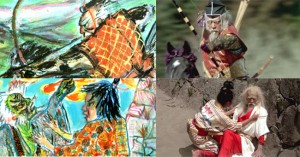Akira Kurosawa, who made Seven Samurai (1954, Japan), was a very ‘hands on’ director, as he was involved in every aspect of the filmmaking process. He wrote or co-wrote his scripts, oversore the costuming and prop design, rehearsed the actors, set up all the shots and then also edited his films.
He would sit down with the writers of his scripts and thoroughly go through each page of the text with them, re-writing and taking notes as they went. Prior to becoming a filmmaker he had been a painter and so he would paint his storyboards (Kurosawa based his compositions on geometric shapes, thus his arrangements of characters and objects needed to be meticulously planned out in advance (Shetty 2015). However, he did not storyboard his films shot for shot as the order and length of shots was generally decided in post production).
Kurosawa’s painted storyboard’s from Ran (1985, Japan).
When shooting he used long lenses that enabled him to film from a distance away from the actors, which he proclaimed made them feel more comfortable. He also had multiple cameras running at once, so that the performers would have no knowledge of which perspective he would choose for the final cut (Smith 2013, p. 74). Even though Kurosawa exercised ultimate control over the actors (he demanded that his cast followed his instructions and script precisely), he believed that the way he utilised the cameras spawned ‘naturalistic’ performances (Dickinson 2012).
Kurosawa often remarked that he shot a film simply in order to have material to edit, because the editing of a picture was the most important and creatively interesting part of the process for him (Smith 2013, p.74). This is the same for me and it is one of the reasons I was drawn to investigating Kurosawa’s method of filmmaking. I think that one of the best parts of creating a film, or a scene, is that sense of satisfaction when everything comes together to make a unified, finished piece of work.
Doing a shoot with multiple cameras would be an interesting exercise because it would mean that the majority of my improvisation would happen during the editing process. For this shoot, I will use a script (rather than a prose) and create a storyboard and floor plan which will map out the positions of the cameras and actors. Because this is only a ‘mini’ investigation, I will just be testing the ‘multicam’ idea with two cameras. I will most likely only be shooting from a static position (i.e. no panning or tilting) because I will be the only camera operator.
REFERENCE LIST
Dickinson, R 2012, Film directors, Geni, viewed 4 May 2015 <http://www.geni.com/projects/Film-directors/1679>.
Shetty, S 2015,The Stunning, Geometric Style of Akira Kurosawa, Browbeat, viewed 4 May 2015 <http://www.slate.com/blogs/browbeat/2015/01/28/every_frame_a_painting_kurosawa_style_tony_zhou_explains_the_geometry_of.html>
Smith, E 2013, The Roman Polanski Handbook – Everything you need to know about Roman Polanski, Emereo Publishing, Aspley, Queensland, pp. 73-77.

